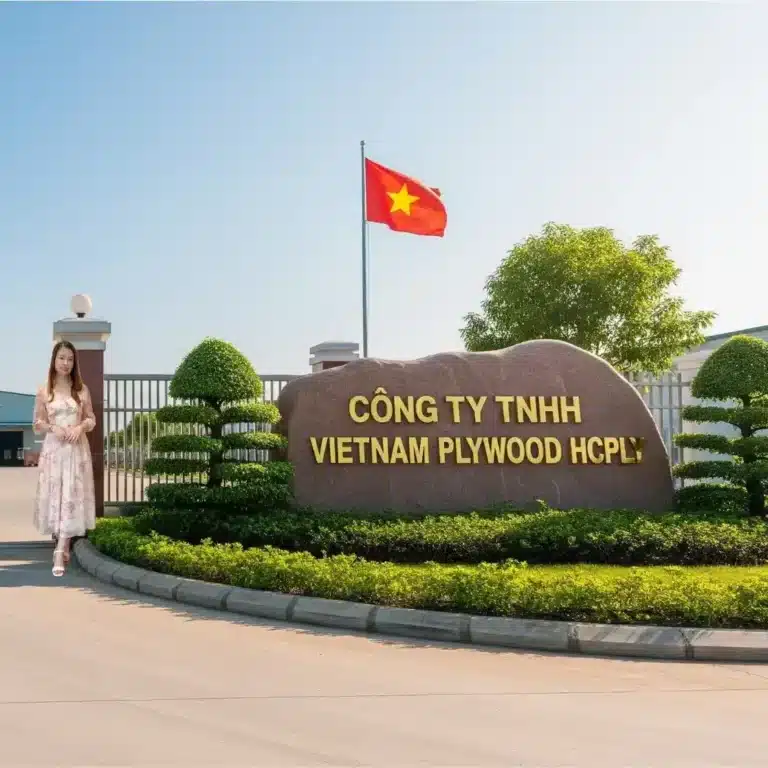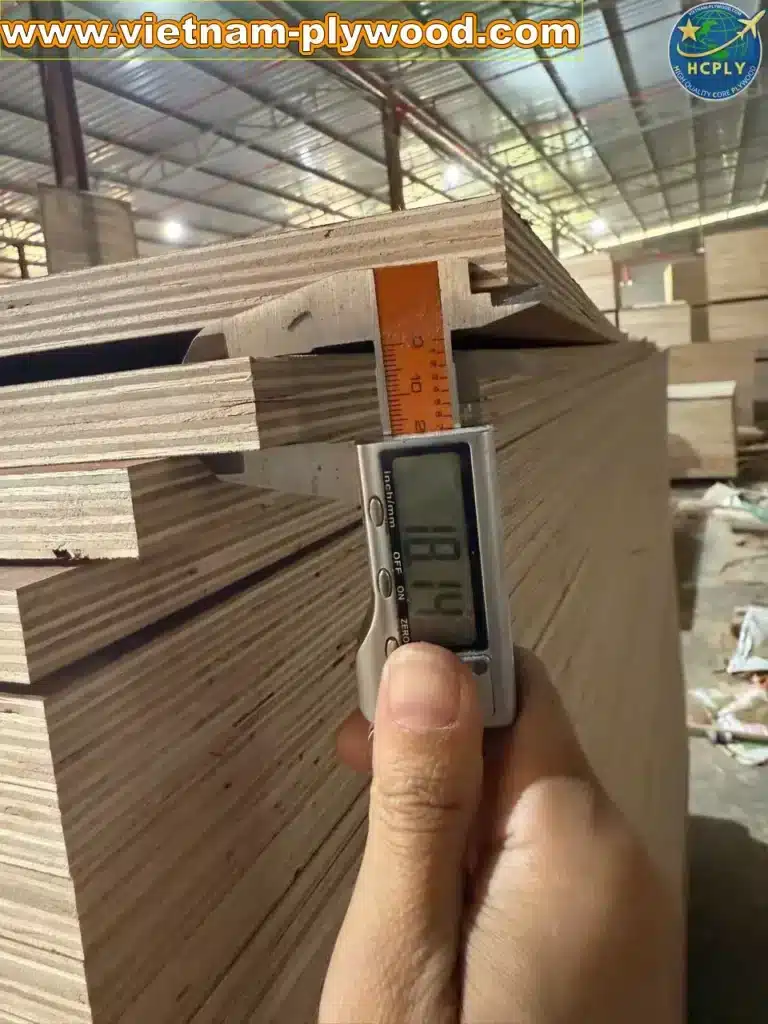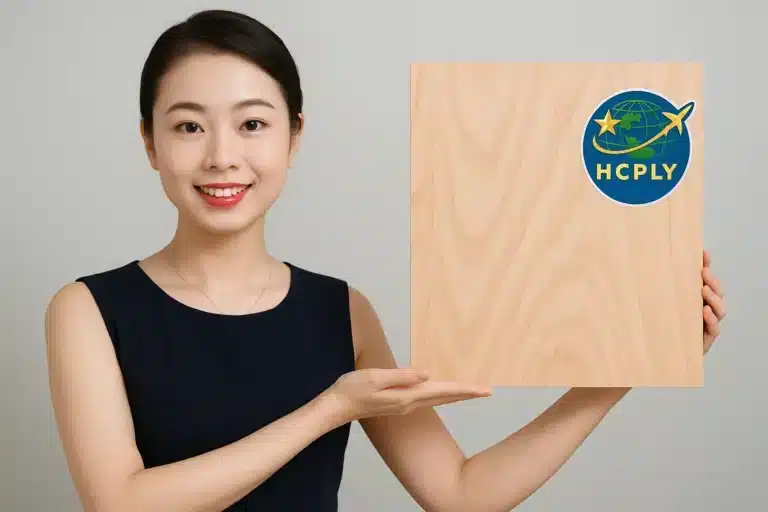Table of contents
Okoume Plywood Manufacturing in Vietnam — Factory Process & QC Checklist (2025)

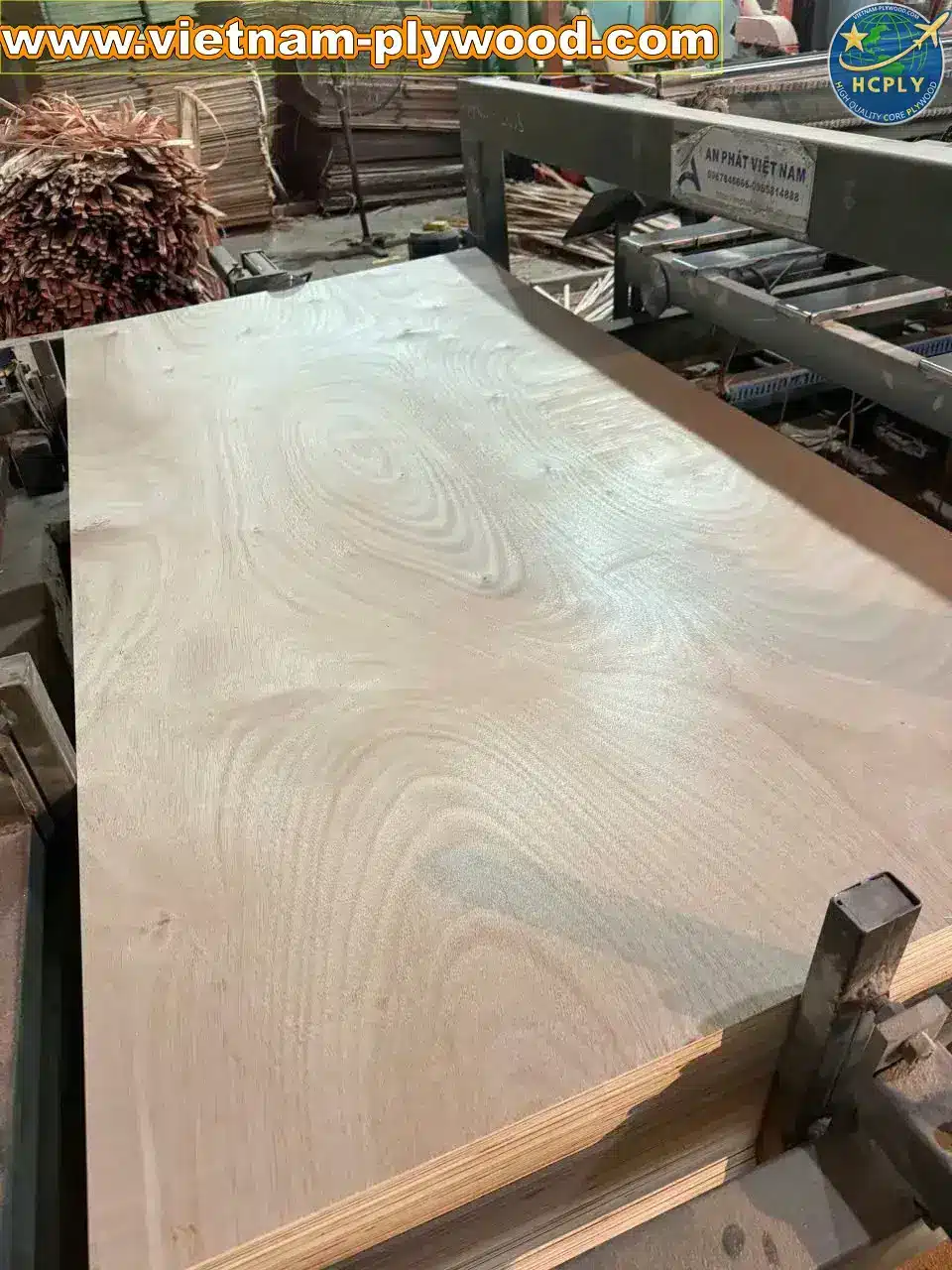
🌍 “From the heart of Vietnam’s factories, a new generation of Okoume plywood is redefining what precision wood engineering means — lightweight, flawless, and export-ready.”
This isn’t just another production line story — it’s the evolution of craftsmanship meeting industrial scale, where okoume plywood manufacturing in Vietnam stands as proof that innovation and quality can coexist in perfect grain alignment.
“Vietnam’s okoume plywood manufacturing industry has evolved from traditional veneer pressing to a globally recognized precision system — balancing strength, lightness, and sustainability. This article takes you inside the real factory process: from veneer moisture calibration to hot-press synchronization, all backed by strict QC and export certifications.”
🌕 1. Raw Materials & Input Standards in Okoume Plywood Manufacturing
In okoume plywood manufacturing, every stage begins with rigorous raw material selection — a factor that determines 80% of the final board quality. Vietnam’s factories have developed precise standards for Okoume face veneers, core veneers, and adhesive systems to maintain international consistency and export-grade finish.
🔹 Veneer Face (Okoume)
- Thickness: 0.2 – 0.6 mm (±0.05 mm tolerance)
- Grading: A/B/C depending on visual uniformity, grain pattern, and patch tolerance
- Defect limit: <2 small patches per sheet, no open knots >5 mm
- Moisture content: 6% – 10% before lay-up
- Colour control: Matched to reference sample for each export batch
🔹 Core Veneer
- Species: Eucalyptus (white core), acacia, or mixed hardwood
- Thickness: 1.5 – 2.2 mm depending on total board thickness
- Moisture: 8% – 12% before glue spreading
- Defect allowance: tight knots ≤10 mm, overlap ≤3 mm
🔹 Adhesive System
| Adhesive Type | Composition | Typical Usage | Glue Spread (g/m²) | Remarks |
|---|---|---|---|---|
| Phenol formaldehyde (PF) | 100 parts PF + 10 parts wheat flour + 10% water | Exterior grade | 180 – 200 | High water resistance |
| Melamine-Urea (MU) | 100 parts MU + 15 parts filler + 15% water | Interior grade | 160 – 180 | Smooth finish |
| Urea-formaldehyde (UF) | 100 parts UF + 10 parts filler + 10% water | Low-cost use | 150 – 170 | For dry-use plywood only |
🔹 Drying & Conditioning Standards
| Step | Parameter | Standard | Purpose |
|---|---|---|---|
| Veneer drying | Temp. 120–140°C | 10–12 min (1.5 mm) | Reach 6–8% MC |
| Equalizing | Room temp (24h) | Humidity 60% | Stabilize veneer before pressing |
💡 Key insight: Maintaining consistent moisture below 10% and precise glue ratio (5–15%) is critical to avoid delamination, warping, or surface blister during hot pressing in Vietnam’s humid production climate.
🌕 2. Veneer Preparation & Lay-Up Sequence in Okoume Plywood Production
In okoume plywood manufacturing, veneer preparation and lay-up define both mechanical strength and visual quality. The process demands precision — every sheet’s orientation, moisture balance, and glue spread must synchronize to achieve the signature smoothness and lightness that distinguishes Vietnam’s okoume plywood production from generic plywood lines.
🔹 Step 1: Veneer Inspection & Trimming
- Incoming veneer QC: Each veneer sheet is checked for splits, overlaps, and color variation using LED inspection tables.
- Trimming tolerance: ±1 mm along the grain, ±2 mm cross-grain.
- Target moisture: 8% (±2%), verified with digital hygrometers.
- Stack organization: Veneers sorted by face grade (A/B/C) and core thickness to ensure uniformity during lay-up.
🔹 Step 2: Glue Spreading & Viscosity Control
Vietnamese factories typically use double roller glue spreaders (250–300 mm diameter) for even coating.
- Viscosity range: 50–70 sec (Ford Cup #4 at 25°C).
- Glue spread: 160–190 g/m² (single side).
- Drying window: Lay-up must occur within 10–20 minutes of spreading to prevent premature gelation.
- Check: Operators perform visual checks every 30 minutes to ensure no dry spots or excessive glue lines.
🔹 Step 3: Veneer Lay-Up Sequence
| Layer | Material | Grain Direction | Notes |
|---|---|---|---|
| Face | Okoume | 0° (along length) | Matched color & grain |
| Cross-core | Acacia/Eucalyptus | 90° | Provides dimensional stability |
| Center core | Mixed hardwood | 0° | Controls stiffness & warp |
| Cross-core | Acacia/Eucalyptus | 90° | Counter-balance tension |
| Back | Okoume (or B-grade face) | 0° | Smooth surface for lamination |
Each lay-up unit (usually 3–7 plies) is pre-aligned on stainless guide rails before pre-pressing. Automation systems in advanced plywood factory okoume lines maintain <±1 mm alignment error across the panel.
🔹 Step 4: Cold Pre-Pressing
- Pressure: 0.8–1.0 MPa
- Duration: 8–10 minutes
- Purpose: To fix veneer stack, remove trapped air, and ensure uniform glue penetration before hot pressing.
💡 Technical insight: Uneven lay-up or moisture imbalance between core and face veneer is the #1 cause of warp and delamination. Vietnamese export-oriented plants use real-time infrared sensors to monitor veneer temperature and surface moisture prior to pressing, ensuring perfect bonding and minimal reject rates.
🌕 3. Hot Pressing Parameters & Press Schedule in Okoume Plywood Manufacturing
In okoume plywood manufacturing, the hot-pressing stage is the decisive moment that defines bonding integrity, surface flatness, and dimensional stability. Vietnamese plywood factories, especially those exporting to Japan and the EU, have refined precise press schedules and control loops that align with international JAS and EN standards. Any deviation in temperature, pressure, or pressing time directly leads to defects such as delamination, blistering, or core voids.
🔹 Pressing Conditions — Standard Parameters
| Parameter | Standard Range | Typical Setup in Vietnam | Purpose |
|---|---|---|---|
| Hot press temperature | 120 – 145 °C | 130 – 135 °C | Activate adhesive curing without overbaking veneer |
| Pressure | 1.0 – 1.4 MPa | 1.2 MPa | Ensure full resin penetration & cohesive bonding |
| Press time | 50 – 60 sec/mm thickness | 5 – 6 min for 9 mm | Complete resin polymerization |
| Cooling phase | 2 – 3 min under 0.3 MPa | 0.4 MPa in Vietnam | Reduce internal stress & prevent warp |
| Core temperature (target) | ≥ 105 °C | Monitored with IR probe | Confirm resin fully cured through the core |
💡 Factories using phenol formaldehyde (PF) resin often run at higher temperatures (140 °C) to achieve export-grade water resistance, while melamine-urea mixes require slightly lower temperature (~125 °C) for smoother surfaces.
🔹 Typical Press Schedule (Export-Grade Okoume Plywood 12 mm)
| Phase | Duration | Temperature | Pressure | Key Objective |
|---|---|---|---|---|
| Pre-heating | 1 min | 80 °C | 0.5 MPa | Gradual moisture equalization |
| Main Pressing | 5 min | 135 °C | 1.2 MPa | Full polymerization of adhesive |
| Pressure Hold | 1 min | 130 °C | 1.3 MPa | Ensure uniform density |
| Cooling Under Load | 2 min | 60–70 °C | 0.4 MPa | Stabilize and prevent spring-back |
🔹 Quality Control & Real-Time Monitoring
Modern okoume plywood production lines in Vietnam integrate automatic pressure loggers and thermocouple feedback systems to maintain consistent parameters across all press openings.
- Cycle uniformity: ±2 °C temperature deviation allowed between platen levels.
- Pressure tolerance: ±0.05 MPa per cylinder verified every 500 cycles.
- Panel flatness: ≤ 0.3 mm/m deviation checked post-pressing using laser sensors.
- Delamination check: 3% sample batch tested per JAS 233-2016 boil test protocol.
🔹 Common Pressing Defects & Countermeasures
| Defect | Cause | Corrective Action |
|---|---|---|
| Blistering / bubbles | High veneer moisture or rapid temperature rise | Pre-dry veneer to 8%, apply staged heat ramp |
| Core voids / delamination | Uneven glue spread or insufficient pressure | Calibrate glue rollers & verify press gauge |
| Surface burn / dark spots | Excessive platen temperature or prolonged cycle | Lower temperature by 5 °C, shorten cycle 10% |
| Warp / twist | Asymmetric lay-up moisture | Equalize MC before assembly (±1%) |
🔧 Expert note: In export-grade plywood factory okoume lines (especially in Binh Duong and Hai Phong), automation systems use Siemens or Omron PLCs to control platen zones independently, maintaining optimal resin cure without overpressure, ensuring balance between strength and lightweight performance — a hallmark of Vietnam’s okoume plywood manufacturing excellence.
🌕 4. Post-Press Conditioning, Sanding & Surface Finishing in Okoume Plywood Manufacturing
After the hot-pressing cycle, okoume plywood manufacturing enters its critical stabilization and finishing phase — a step that determines surface flatness, panel thickness accuracy, and aesthetic appeal. Vietnamese plywood factories prioritize this phase to ensure that every exported sheet meets strict international tolerances and aesthetic benchmarks demanded by furniture and interior industries.
🔹 Cooling & Conditioning
- Resting period: Panels are stacked in open racks for 24–48 hours to release internal stress accumulated during hot pressing.
- Stacking method: Alternating layer orientation with spacers every 15–20 sheets allows airflow to normalize panel moisture.
- Ambient conditions: 25–30°C, 60–70% RH — controlled to prevent moisture gradient across the core.
- Target core moisture: 8–10%, measured at both ends and center using calibrated pin-type moisture meters.
💡 Insight: Without proper conditioning, okoume plywood may show delayed warping, edge cracking, or surface blisters after export shipment, especially in humid destinations like India or Africa.
🔹 Sanding Line Process
High-end plywood factory okoume production lines in Vietnam utilize wide-belt sanding machines (two-head or four-head, 1,300 mm width) from brands like Kundig or Timesavers.
| Stage | Grit | Purpose | Feed Speed | Remarks |
|---|---|---|---|---|
| Calibration | 60–80 | Flatten overall thickness | 10–15 m/min | Removes minor press marks |
| Intermediate | 120–150 | Refine surface | 15–20 m/min | Evens fiber tear-outs |
| Finishing | 180–240 | Prepare for lamination or veneer | 20–25 m/min | Ensures <±0.15 mm thickness tolerance |
- Dust extraction: Central suction line maintaining ≤1.5 m/s velocity to prevent sanding burn marks.
- Panel inspection: 100% checked under diffused LED panels for uniform texture.
🔹 Surface Repair & Face Grading
- Putty composition: 2-part epoxy + okoume dust, color-matched to batch tone.
- Allowable patch area: ≤3% of total surface for grade A/B, ≤5% for grade C.
- Final grading: Per EN 635-2 and JAS 233-2016 — exported lots labeled as A/B, A/C, or B/B accordingly.
💡 Technical note: Vietnamese manufacturers often regrade each lot post-sanding since okoume veneer color may shift subtly during pressing. Maintaining this inspection standard is what ensures the “furniture-ready” look that defines okoume plywood production quality from Vietnam.
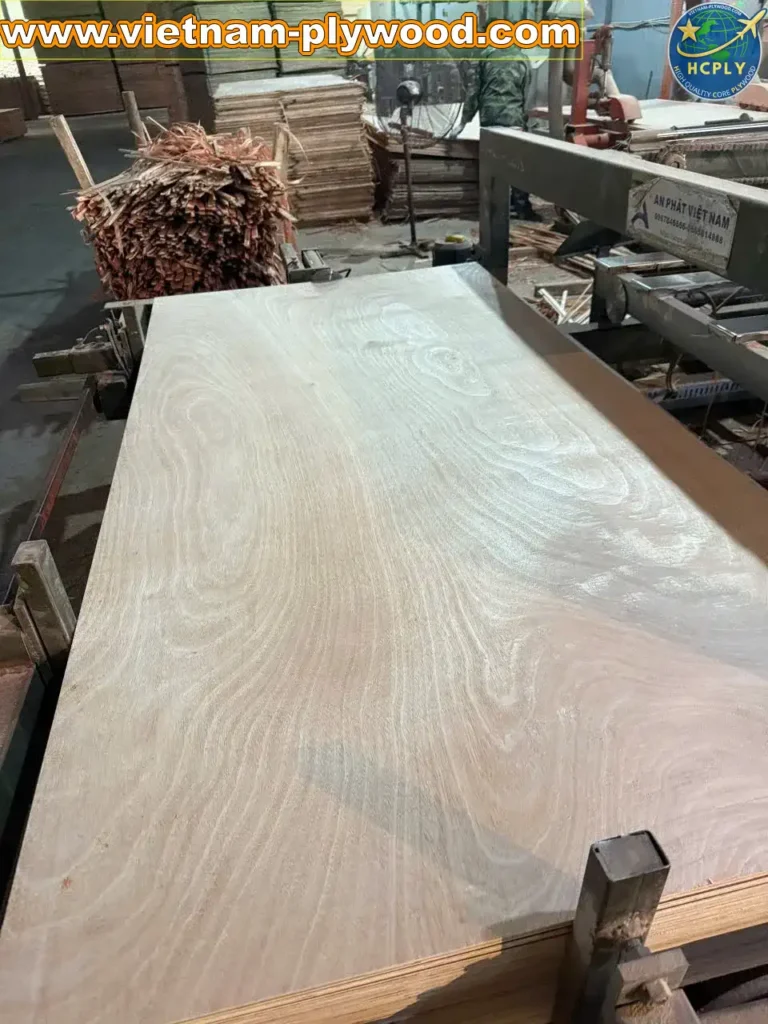
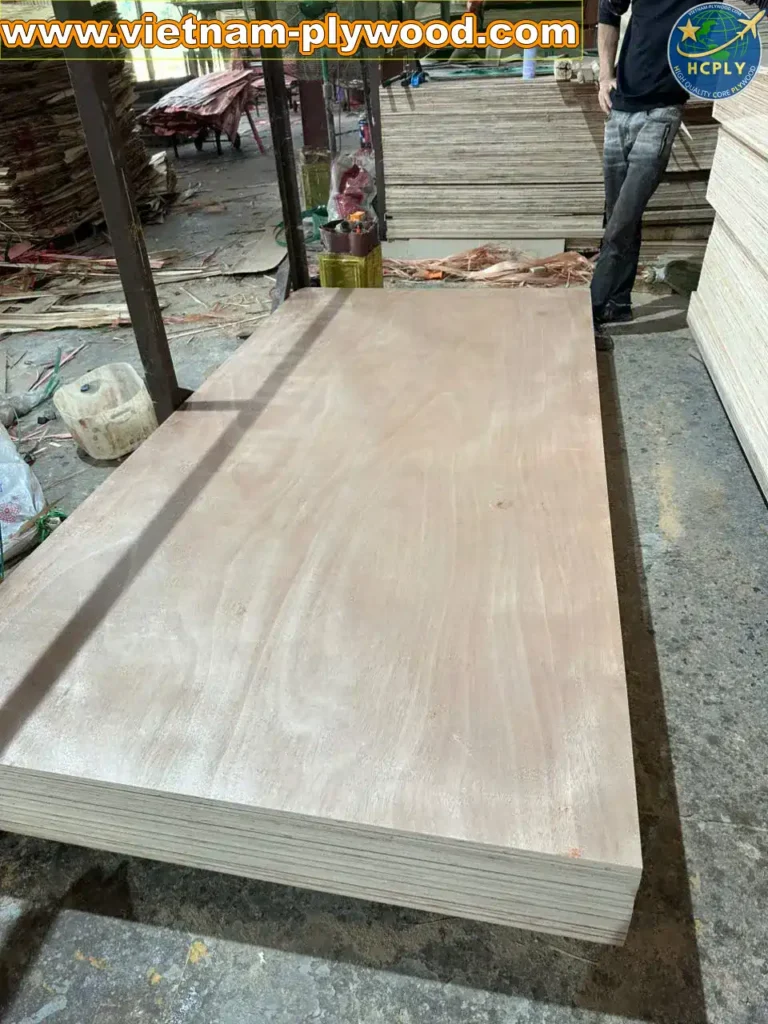
🌕 5. Quality Control (QC) Checklist for Okoume Plywood Manufacturing
The quality control phase in okoume plywood manufacturing is where every parameter — from core bonding to final appearance — is verified against export-grade benchmarks. Vietnam’s plywood factories have evolved sophisticated QC systems based on JAS, EN 314-2, and ISO 9001 frameworks, ensuring each batch is traceable, consistent, and ready for international shipment.
🔹 In-Process Quality Control
| Inspection Stage | Parameter | Standard / Tolerance | Inspection Frequency | Equipment Used |
|---|---|---|---|---|
| Veneer Drying | Moisture content | 6–10% | Every batch | Digital moisture meter |
| Glue Preparation | Viscosity | 50–70 sec (Ford Cup #4) | Every 2 hours | Ford Cup, Thermometer |
| Lay-Up Assembly | Alignment error | ≤ ±1 mm | Continuous (visual + laser guide) | Alignment laser |
| Hot Press Cycle | Core temp / Pressure | ≥105°C / 1.2 MPa | Every 10 cycles | Thermocouple & pressure logger |
| Thickness Calibration | Panel thickness | ±0.2 mm | Every 20 sheets | Micrometer, caliper |
💡 Key insight: Consistent core temperature and adhesive penetration are decisive in preventing internal voids — the most common defect found during boil testing of okoume plywood in Vietnam.
🔹 Final Inspection & Export Testing
| Test Type | Method / Standard | Acceptable Limit | Sampling Ratio | Purpose |
|---|---|---|---|---|
| Boil test | JAS 233-2016 / EN 314-2 | No delamination after 6h boil + 2h dry + 6h boil | 3% per lot | Verify glue bond strength |
| Bending strength (MOR) | EN 310 | ≥ 45 MPa (longitudinal) | 1 per 100 sheets | Ensure structural reliability |
| Moisture equilibrium | Internal method | 8–12% | Random check | Confirm stability pre-shipment |
| Surface smoothness | ASTM D2457 | Ra ≤ 6 µm | 100% inspection | Guarantee lamination readiness |
| Formaldehyde emission | EN 717-1 | E1 ≤ 0.124 mg/m³ | Once per 50 m³ | Environmental compliance |
💬 Technical note: Export-oriented factories such as those in Binh Duong, Phu Tho, and Hai Phong routinely integrate third-party audits by SGS, Intertek, or Bureau Veritas to maintain traceability for EU and Japanese importers.
🔹 Packaging & Pre-Shipment QC
| Step | Requirement | Description |
|---|---|---|
| Edge sealing | Two coats of waterproof acrylic | Prevent edge absorption during sea transport |
| Stack alignment | Max deviation ≤ 10 mm | Ensures even pallet loading |
| Wrapping | PE film + corner guard + steel strap | Moisture & impact protection |
| Marking | Product name, thickness, batch code, factory logo | For full traceability in customs clearance |
| Container loading | Even weight distribution (≤2% imbalance) | Verified via forklift scale before sealing |
📦 Export insight: Vietnam’s plywood exporters maintain an average rejection rate under 0.5%, among the lowest in Asia, due to multi-stage QC combined with moisture-stabilization storage before shipment.
✅ Summary:
The QC framework in okoume plywood manufacturing in Vietnam bridges precision manufacturing with strict compliance. Through controlled adhesive chemistry, temperature profiling, and layered verification, factories achieve the high consistency required for Japan, EU, and Middle East markets — where okoume plywood is valued for its lightweight yet durable core structure.
🌕 6. Export Packaging, Labeling & Container Loading Standards for Okoume Plywood Vietnam
The final stage of okoume plywood manufacturing — packaging and container loading — is not merely about logistics. For export-oriented factories in Vietnam, this phase represents the bridge between production precision and global market credibility. Poor packaging or uncontrolled container humidity can lead to edge swelling, delamination, or surface discoloration after long-distance sea transport. Therefore, every detail in this stage is standardized to meet international shipping requirements (ISPM 15, ASTM D6257, EN 13986).
🔹 Export Packaging Specification
| Component | Specification | Function |
|---|---|---|
| Wrapping | 0.08 mm PE stretch film + waterproof kraft paper | Moisture & dust protection |
| Edge sealing | Two coats of waterproof acrylic or phenolic paint | Prevents water absorption during transport |
| Strapping | 3–4 steel straps (19 mm width, 0.8 mm thick) cross-tied | Structural stability |
| Corner protection | PVC or paperboard guards (2–3 mm) | Prevent strap indentation |
| Pallet base | Heat-treated pine (ISPM 15 compliant) | Safe for export inspection |
| Marking | Factory logo, product name, dimension, batch code, “Made in Vietnam” | Customs and traceability compliance |
💡 Tip: Many Vietnam plywood exporters (especially in Hai Phong & Binh Duong) use PE-laminated kraft wrapping instead of simple film to reduce condensation risk during sea freight, particularly on long routes to India, UAE, and North Africa.
🔹 Container Loading Standards
| Container Type | Capacity | Loading Method | Weight Distribution | Key Note |
|---|---|---|---|---|
| 20’ GP | 28–30 CBM (approx. 20 tons) | 8–10 bundles, double stacked | ±2% balance | Used for partial shipments or specialty thickness |
| 40’ HC | 45–48 CBM (max. 26 tons) | 16–18 bundles, 2-tier stacking | ±2% balance | Standard for full export lots |
| Lashing method | Polyester strap + wooden blocking | Prevents lateral shifting | Required for safety audits |
To maintain humidity stability during voyage, factories install desiccant bags (2–3 kg per 20’ container) or humidity-control packs along the container walls. Some major exporters also use digital temperature and RH loggers (HOBO MX2300 series) to record conditions for customer assurance reports.
🔹 Labeling & Export Documentation
Each bundle includes both internal and external labels:
- Internal label: Hidden under film; includes production date, shift code, inspector ID, adhesive batch.
- External label: Visible side; includes “Okoume Plywood Vietnam,” dimensions (e.g., 1220×2440×12mm), grade (A/B, B/B), quantity, and export order number.
Export paperwork complies with:
- FSC Chain of Custody (CoC)
- CARB/EPA TSCA Title VI for formaldehyde emission
- Phytosanitary certificate (for pallet base)
- Packing list, invoice, and certificate of origin (Form B or EUR.1)
📦 Summary:
The excellence of okoume plywood manufacturing in Vietnam doesn’t stop at production. By integrating ISPM 15-compliant pallets, controlled humidity packing, and traceable labeling, Vietnam’s factories ensure every shipment of okoume plywood arrives intact, flawless, and ready for global markets. This meticulous packaging culture reflects not only export professionalism but also the sustainable manufacturing standards HCPLY represents.
🌕 7. Sustainability & Compliance in Okoume Plywood Manufacturing
Okoume plywood manufacturing in Vietnam has entered a new phase — one defined not just by precision or export quality, but by sustainability and international compliance. As global buyers in the EU, UK, and US markets tighten environmental and traceability regulations (notably EUDR, CARB P2, FSC, and TSCA Title VI), Vietnamese factories have transformed their production lines to meet the full spectrum of eco-certification and green manufacturing standards.
🔹 FSC & Legal Wood Sourcing
All okoume plywood exported from Vietnam must be verifiably sourced under FSC Chain of Custody (CoC) or PEFC-recognized systems. This ensures that every cubic meter of veneer — whether imported okoume from Gabon or domestic eucalyptus — carries documented legality:
- Traceability system: barcode tagging from log to finished sheet.
- Supplier audit frequency: once per quarter under ISO 38200 framework.
- Imported okoume veneer: must have FLEGT or EUTR-equivalent legality proof.
- Domestic core veneer: from plantation timber registered with the Vietnam Timber Association (Viforest).
🔹 Formaldehyde & Emission Standards
To align with European EN 717-1 and US EPA TSCA Title VI, factories maintain emission levels well below E1 grade limits:
| Grade | Formaldehyde Emission (mg/m³) | Compliance Standard | Testing Frequency |
|---|---|---|---|
| E0 | ≤ 0.050 | EN 717-1 / JIS A1460 | Every 50 m³ |
| E1 | ≤ 0.124 | EN 717-1 / CARB P2 | Every 30 m³ |
| E2 | ≤ 0.500 | Internal use only | — |
💡 Most export-oriented okoume plywood plants in Vietnam operate under continuous monitoring using desiccator or chamber tests, ensuring that each lot meets E1 or better performance.
🔹 Energy Efficiency & Carbon Footprint
Factories are transitioning toward steam boiler systems using biomass fuel (rice husk, wood chips) instead of coal to cut CO₂ emissions by up to 35%.
- Heat recovery systems reuse exhaust air from veneer dryers.
- LED inspection lines reduce energy consumption by 20%.
- Average energy use: 0.85 kWh per m² of 12 mm okoume plywood — already 25% lower than 2019 levels.
🔹 Waste Management & Reuse
| Waste Type | Reuse / Treatment | Impact |
|---|---|---|
| Veneer trim & core offcut | Reused as boiler fuel | Zero landfill |
| Sanding dust | Mixed into phenolic glue filler | Material recycling |
| Wastewater | Treated via 3-stage sedimentation & neutralization | Meets QCVN 40:2011/BTNMT |
| Defective panels | Re-sanded & sold as B-grade | Yield recovery up to 96% |
🔹 Certification & Continuous Improvement
Vietnamese manufacturers, including HCPLY – Vietnam Plywood Manufacturer & Supplier, regularly
🌕 8. Certification & Continuous Improvement in Okoume Plywood Manufacturing
In Vietnam’s okoume plywood manufacturing sector, certification and continuous improvement have become strategic pillars to ensure sustainable competitiveness and export credibility. Factories like HCPLY – Vietnam Plywood Manufacturer & Supplier continuously upgrade production systems, documentation, and quality monitoring to align with the world’s strictest plywood compliance standards — from FSC and EUDR to CARB P2 and JAS.
🔹 Integrated Certification Framework
Vietnamese factories producing okoume plywood for export typically operate under a multi-layered certification system that covers environment, process, and product performance:
| Certification | Scope | Compliance Focus | Audit Frequency | Applicable Market |
|---|---|---|---|---|
| ISO 9001:2015 | Quality management | Consistency in veneer selection, hot press control, QC documentation | Annual | Global |
| FSC-CoC (Chain of Custody) | Material traceability | Legal timber sourcing, forest sustainability | Twice per year | EU / UK / USA |
| CARB P2 / EPA TSCA VI | Emission control | Low formaldehyde release (≤0.124 mg/m³) | Every 50 m³ | North America |
| JAS 233-2016 / EN 314-2 | Mechanical strength & bonding | Boil test, bonding durability | Quarterly | Japan / EU |
| EUDR (2025) | Deforestation-free compliance | Verified geographic origin of raw wood | Ongoing | EU only |
💡 Key Insight: A fully certified okoume plywood factory in Vietnam must maintain synchronized data across these frameworks — from glue batch numbers to veneer origin coordinates — ensuring complete traceability from log to shipment.
🔹 Digitalization & Smart Factory Upgrade
Leading Vietnam plywood manufacturers have adopted Industry 4.0 systems to track production and QC in real time:
- RFID tagging for every pallet of okoume plywood.
- Cloud-based data integration connecting moisture sensors, glue spreaders, and press loggers.
- AI-assisted visual inspection cameras identifying veneer defects before pressing.
- Statistical Process Control (SPC) dashboards that alert deviations instantly.
These smart systems not only improve efficiency but also help maintain stable product parameters required by okoume plywood manufacturing standards for export — from dimensional accuracy (±0.2 mm) to color uniformity across batches.
🔹 Continuous Improvement & Global Benchmarking
Vietnam’s plywood sector invests heavily in training and international benchmarking:
- Cross-audits with Japanese and European clients ensure continuous improvement.
- Annual R&D budgets (1–2% of revenue) focus on lightweight core combinations and improved bonding formulas.
- Sustainability teams monitor carbon reduction, achieving up to 35% lower CO₂ emissions compared to pre-2020 levels.
📈 Result: The best okoume plywood manufacturing in Vietnam now rivals long-established suppliers in Indonesia and China, not only in quality but also in traceable, certified production methods.
✅ Summary:
Certification and continuous improvement are what transform okoume plywood manufacturing in Vietnam from mass production to precision craftsmanship. With every audit, system upgrade, and compliance milestone, HCPLY and its peers reaffirm Vietnam’s leadership in producing world-class, sustainable, and export-ready okoume plywood for the global market.
🌕 9. Conclusion: The Benchmark of Okoume Plywood Manufacturing in Vietnam
Vietnam has firmly positioned itself as a global hub for okoume plywood manufacturing, combining technical mastery, sustainable sourcing, and world-class quality assurance. From precision-controlled hot-pressing lines and optimized glue spread ratios to real-time digital monitoring, the nation’s factories are redefining what it means to produce premium okoume plywood at scale.
Okoume veneer — prized for its lightness, even grain, and warm tone — demands exacting control throughout production. By standardizing core bonding at ≥1.2 MPa, maintaining veneer moisture between 6–10%, and applying E1-compliant adhesive systems, Vietnamese plywood plants ensure stable performance across global climates. Each exported sheet of okoume plywood carries the credibility of meticulous craftsmanship aligned with ISO 9001, FSC, and CARB P2 standards.
What truly distinguishes okoume plywood production in Vietnam is its balance between industrial precision and environmental responsibility. Factories like HCPLY – Vietnam Plywood Manufacturer & Supplier implement closed-loop waste management, biomass-powered heating, and full traceability — from Gabon-sourced okoume logs to the final sealed container.
💡 Industry Insight: By 2025, Vietnam’s certified okoume plywood capacity is projected to exceed 250,000 m³ per year, supplying markets from Japan to Europe with consistent quality, legal sourcing, and zero-defect packaging.
✅ Final Summary:
- Vietnam’s okoume plywood factories combine advanced process control with export-standard certification.
- Sustainability and digitalization are no longer optional but integral to competitiveness.
- The result: Okoume plywood from Vietnam now stands among the finest in the world — precise, eco-compliant, and globally trusted.
🌕 10. Future Outlook: Innovation & Global Positioning of Okoume Plywood Manufacturing in Vietnam
Vietnam’s okoume plywood manufacturing industry is entering a decisive growth decade driven by automation, sustainability, and global trade alignment. Between 2025–2030, Vietnam is projected to move beyond traditional OEM production toward innovation-led plywood engineering, positioning itself as Southeast Asia’s benchmark for precision, eco-compliant manufacturing.
🔹 Technological Innovation and Smart Manufacturing
Factories are integrating AI-driven moisture control, infrared veneer grading, and automated hot-press synchronization to maintain dimensional consistency within ±0.15 mm — a level once limited to Japanese mills.
- Predictive Maintenance Systems: Using IoT sensors to track press plate deformation and adhesive curing time in real-time.
- Automated Glue Kitchens: Equipped with viscosity feedback loops that adjust resin-solid ratios automatically.
- Inline Ultrasonic Testing: Detects internal voids before trimming, reducing reject rates below 0.3% per shipment.
🔹 Market Diversification & Export Trends
By 2027, okoume plywood exports from Vietnam are expected to surpass 300,000 m³/year, led by demand from:
| Region | Key Specification Demand | Growth Rate (YoY) | Certification Priority |
|---|---|---|---|
| Japan | JAS-certified, lightweight panels | 6.2% | JAS 233-2016, E0 |
| EU | FSC + EUDR compliant, low emission | 8.4% | FSC-CoC, EN 13986 |
| Middle East | High moisture resistance | 4.7% | EN 314-2, ISO 9001 |
| USA | CARB P2 + moisture-stabilized panels | 7.5% | CARB P2, TSCA VI |
This trend reflects Vietnam’s strategic shift from being a price-driven exporter to a quality-and-compliance leader in the global plywood supply chain.
🔹 Sustainable Expansion & Green Transition
Sustainability will define the next phase of Vietnam’s plywood evolution:
- Zero-Emission Factories: Implementation of biomass boilers and solar-assisted dryers to reduce CO₂ footprint by >40%.
- Reforestation Partnership Programs: Collaboration with Viforest and WWF-Vietnam to certify plantation timber sources under FSC 100%.
- Water Recycling Systems: Achieving 85–90% recovery through multi-stage sedimentation and filtration.
💡 Industry Projection
By 2030, HCPLY – Vietnam Plywood Manufacturer & Supplier and its peers will operate as vertically integrated ecosystems — from veneer processing to export logistics — achieving real-time global traceability and predictive production analytics. This transformation cements Vietnam’s reputation as a world-class center for okoume plywood manufacturing, uniting innovation, quality, and sustainability in every cubic meter exported.
📞 Work With Vietnam’s Leading Okoume Plywood Factory
If you’re sourcing okoume plywood or planning OEM production, contact HCPLY – Vietnam Plywood Manufacturer & Supplier.
Lucy (Export Project Leader)
📧 [email protected] | 📱 WhatsApp: +84-975807426
🔗 Visit HCPLY’s Okoume Plywood Page

